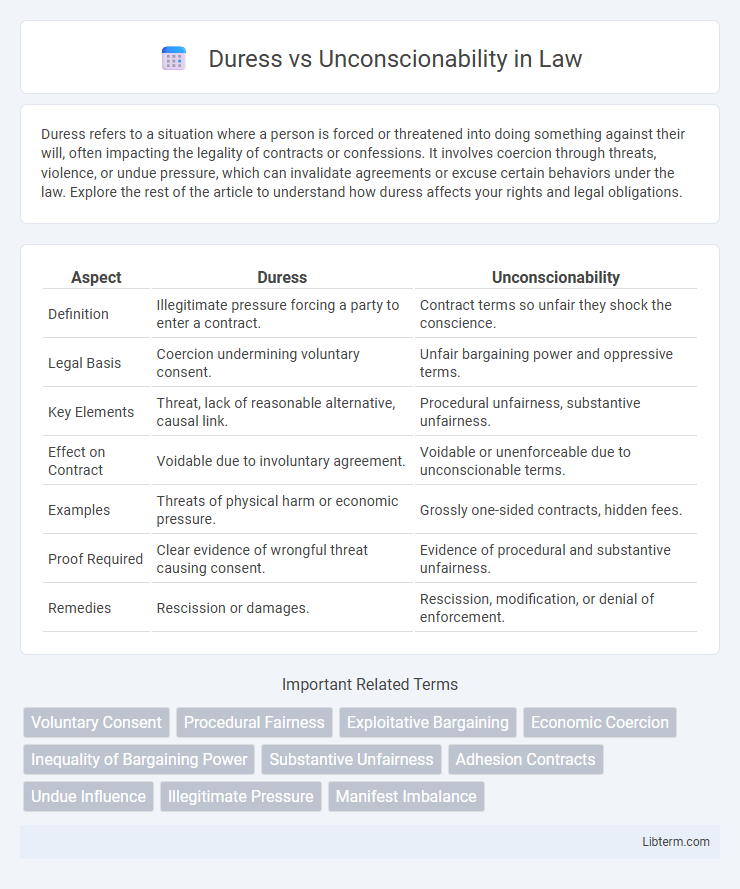Duress refers to a situation where a person is forced or threatened into doing something against their will, often impacting the legality of contracts or confessions. It involves coercion through threats, violence, or undue pressure, which can invalidate agreements or excuse certain behaviors under the law. Explore the rest of the article to understand how duress affects your rights and legal obligations.
Table of Comparison
| Aspect | Duress | Unconscionability |
|---|---|---|
| Definition | Illegitimate pressure forcing a party to enter a contract. | Contract terms so unfair they shock the conscience. |
| Legal Basis | Coercion undermining voluntary consent. | Unfair bargaining power and oppressive terms. |
| Key Elements | Threat, lack of reasonable alternative, causal link. | Procedural unfairness, substantive unfairness. |
| Effect on Contract | Voidable due to involuntary agreement. | Voidable or unenforceable due to unconscionable terms. |
| Examples | Threats of physical harm or economic pressure. | Grossly one-sided contracts, hidden fees. |
| Proof Required | Clear evidence of wrongful threat causing consent. | Evidence of procedural and substantive unfairness. |
| Remedies | Rescission or damages. | Rescission, modification, or denial of enforcement. |
Understanding Duress: Legal Definition
Duress occurs when one party is forced into a contract through threats, violence, or unlawful pressure, invalidating genuine consent. Legal definitions require proof that the victim had no reasonable alternative but to agree due to imminent harm or coercion. Courts assess whether such pressure overcame the victim's free will, rendering the agreement voidable under duress principles.
What Constitutes Unconscionability?
Unconscionability arises when a contract is so one-sided that it shocks the conscience, often involving an imbalance of power between the parties and absence of meaningful choice. Courts consider procedural factors such as unfair surprise or oppression during contract formation and substantive factors like unjust terms that heavily favor one party. The doctrine serves to protect parties from agreements that are fundamentally unfair and exploitative, beyond mere pressure or threats seen in duress cases.
Key Differences Between Duress and Unconscionability
Duress involves unlawful pressure or threats that force a party to enter into a contract against their free will, compromising the validity of consent. Unconscionability refers to a contract or term that is so one-sided or unfair at the time of agreement that it shocks the conscience, often due to significant inequality in bargaining power or knowledge. Key differences include duress focusing on coercion affecting consent, while unconscionability centers on the substantive fairness and reasonableness of the contract terms.
Types of Duress in Contract Law
Types of duress in contract law primarily include physical duress, where one party is forced into agreement through threats of bodily harm, and economic duress, which involves coercion by unlawful or wrongful threats affecting economic interests, such as threats to breach a contract causing financial harm. Other forms include duress to goods, where threats target property, and threats to commence or withhold civil actions improperly. Recognizing these types is crucial for determining contract validity, as duress can render agreements voidable due to lack of genuine consent.
Forms of Unconscionable Conduct
Unconscionable conduct in contract law often involves terms or actions that are excessively unfair or one-sided, including procedural unconscionability like deceptive bargaining tactics and substantive unconscionability such as oppressive contract terms. Unlike duress, which requires wrongful threats or coercion undermining free will, unconscionability addresses the overall fairness and equity in the contract's formation and content. Courts scrutinize elements such as unequal bargaining power, hidden clauses, and exploitative conditions to determine if unconscionability voids enforceability.
Elements Required to Prove Duress
Proving duress requires demonstrating that one party experienced an improper threat or wrongful act that left no reasonable alternative but to agree to the contract. The elements include an immediate threat of harm, coercion that overcomes the victim's free will, and that the victim's consent was obtained through this coercion. Unlike unconscionability, which centers on unfair terms and bargaining power imbalance, duress focuses primarily on the presence of illegitimate pressure or threats.
Criteria for Establishing Unconscionability
Unconscionability requires a demonstration of both procedural and substantive unfairness, where the contract terms are so oppressive that they shock the conscience. Procedural elements include factors like unequal bargaining power and lack of meaningful choice, while substantive factors examine overly harsh or one-sided terms disadvantaging one party. Courts often assess the overall context, including the parties' knowledge, the contract's commercial reasonableness, and whether the terms are consistent with public policy.
Judicial Approaches to Duress and Unconscionability
Judicial approaches to duress prioritize the presence of wrongful pressure that overcomes the victim's free will, requiring clear evidence of coercion such as threats or physical force. Courts analyze unconscionability by examining both procedural factors, like unequal bargaining power or lack of meaningful choice, and substantive unfairness in contract terms, focusing on contracts that shock the conscience. Distinctively, duress invalidates agreements due to improper threats, while unconscionability addresses imbalances and unfairness in contract formation and terms, with courts often applying a combined objective-subjective test to protect vulnerable parties.
Common Case Law Examples
Duress involves wrongful threats that overcome a party's will, with classic case law including Barton v Armstrong (1976), where violence threats rendered a contract voidable. Unconscionability focuses on unfair oppression or exploitation in contract terms, demonstrated in Williams v Walker-Thomas Furniture Co. (1965), where grossly one-sided agreement terms were not enforced. Both doctrines protect contract fairness, but duress requires improper threats, while unconscionability centers on the substantive unfairness in bargaining.
Practical Implications for Contractual Parties
Duress in contract law involves coercion that leaves a party with no reasonable alternative, rendering the agreement voidable to protect parties from unfair pressure. Unconscionability addresses contracts that are so one-sided or oppressive that they shock the conscience, allowing courts to refuse enforcement to prevent injustice. Contractual parties must carefully evaluate negotiations to avoid duress claims and ensure terms are balanced to reduce the risk of unconscionability challenges, promoting fair and enforceable agreements.
Duress Infographic

 libterm.com
libterm.com